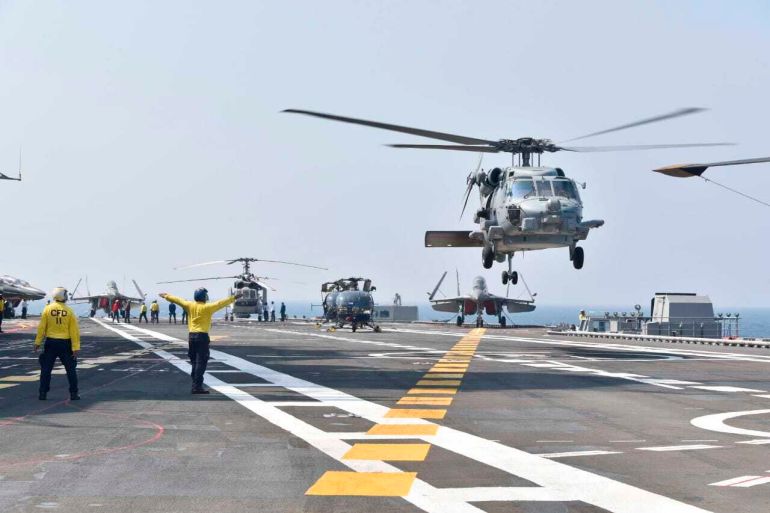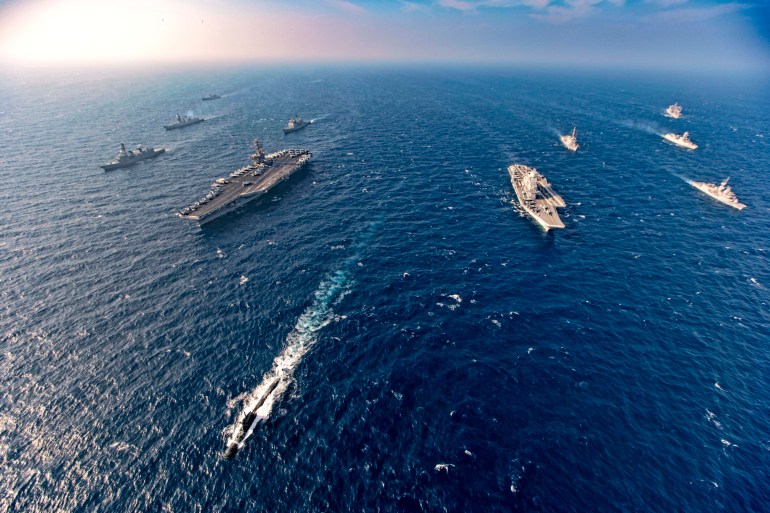‘Here to stay’: Indo-Pacific Quad leaders to meet at White House
First in-person leader meet of US, Japan, India and Australia grouping signals ‘durability’ despite differences.

The leaders of the United States, Japan, India and Australia will meet on Friday for their first in-person person summit of the Indo-Pacific Quadrilateral Security Dialogue, or so-called “Quad” grouping.
The informal arrangement, with the countries first working together in response to the 2004 Indian Ocean earthquake and tsunami, has increasingly solidified since 2017. It has been fuelled by consecutive US administration’s policies towards China, and aided in no small part by individual tensions between Tokyo, Canberra, New Delhi with Beijing.
Keep reading
list of 4 itemsWhat is the Quad and can it counter China’s rise?
Quad goals: US, Indo-Pacific allies to up India’s vaccine output
Can the Quad effectively counter China’s influence?
Quad meetings in recent years have gradually worked their way up in the chain of command, with the grouping holding its first – albeit virtual – summit in March.
Heading into the first in-person leaders meeting, the survival of the current iteration of the grouping across two US administrations and changes in governments in Japan and Australia “speaks to [the Quad’s] durability and how, you could say, the quad is here to stay,” Sameer Lalwani, a senior fellow for Asia strategy at the Stimson Center, told Al Jazeera.
“It’s going to be a real institution … I think it’s going to be a grouping that will occupy the minds in the planning of Washington’s defence and diplomatic community for the coming years,” he said.
While the four nations’ concerns about an increasingly assertive China in the Indo Pacific region have created a patch of common ground, Lalwani added, the grouping’s emerging objectives have included a “Swiss Army knife of public goods deliveries to the Indo Pacific”.
Following the summit in March, the quartet released a joint statement promoting “a free, open rules-based order”, pledging to combine “medical, scientific, financing, manufacturing and delivery” capacity for COVID-19 vaccines, and combating climate change.
It also announced the creation of working groups on “critical and emerging” technologies, with 5G infrastructure investment and semiconductor supply chain issues expected to be addressed going forward.
Although China loomed large, the March joint statement did not specifically refer to the superpower.
Solidifying grouping
Observers say the Quad grouping is still finding its footing. Its varied – and at times opaque – goals reflect the precarious balancing acts for Australia, India, and Japan, who see benefits in cooperating amid a crush of regional and global issues, but fear threatening their intricate and distinct ties with Beijing.
Nevertheless, while the three countries showed wariness towards the ideologically charged emphasis on China under the administration of former President Donald Trump, all three have tended, to various extents, towards addressing China more directly, although they continue to stress they do not consider the arrangement as solely a bulwark against China’s military might.
Still, in August, the navies of Australia, India, Japan and the US held sprawling naval exercises in the Pacific for the second year in a row, this time off the coast of Guam. The countries have maintained that the Malabar drills, which had previously included only the US and India, do not fall under the auspices of the Quad.

Meanwhile, Japan and Australia have shown more willingness to take an explicit stand against China in the region, even with Beijing representing Tokyo’s second-largest trading partner and Canberra’s largest.
Following a summit in April, Japanese Prime Minister Yoshihide Suga released a joint statement with US President Joe Biden criticising China’s “unlawful maritime claims and activities in the South China Sea”, actions surrounding the Japanese administered Senkaku Islands (known as Diaoyu in China), while underscoring “the importance of peace and stability across the Taiwan Strait”.
The statement was unique for not only referring to China by name – something Tokyo had traditionally not been wont to do as part of a larger policy of ambiguity towards the neighbouring superpower – but for also referring to China’s military actions towards Taiwan. The last time both countries named the island in a joint statement was in 1969.
In an interview on Wednesday with Bloomberg, Suga warned that China’s military rise “could present a risk to our country’s peace and prosperity” and advocated for strengthened defence ties with the US. He added it remained important for Japan and China to maintain dialogue.
Meanwhile, just days before Friday’s Quad summit, the US, Australia and the United Kingdom announced a new Indo-Pacific security pact, AUKUS, that included a deal to provide Canberra with nuclear-powered submarines. White House press secretary Jen Psaki on Wednesday ruled out the prospect of Japan or India being invited to the security partnership.
Unsurprisingly, Beijing has been quick to condemn AUKUS, calling it “extremely irresponsible” and accusing the countries of “intensifying an arms race” in the region.
An editorial in the Chinese state-run Global Times tabloid, which had previously derided the Quad grouping the “Asian NATO”, on Tuesday latched on to criticism that Biden’s actions were leading to a “new cold war”.
It added the US has done the “utmost to inject into the Quad the narrative of military cooperation aimed at China”.
India’s role
India’s decision to continue to engage with the Quad, meanwhile, is particularly significant, said Ethan Paul, a senior researcher at the Quincy Institute for Responsible Statecraft, noting that New Dehli is less concerned about the South China Sea than the other nations, and more concerned with its disputed border with China and maritime security in the Indian Ocean.
India, the only Quad country that shares a land border with China, has a particularly “delicate balancing game to play”, he added. The two countries are continuing to contend with a long-simmering border dispute. In June 2020, clashes in the Galwan Valley turned deadly.
“Seeing how India plays that game going forward, while maintaining its relationship with the Quad and its commitment to its vision for Asia is, in my view, of immense consequences for the Quad itself but also the future of the region,” Paul told Al Jazeera.
Particularly telling, he added, will be how India responds to tensions surrounding Taiwan, which have become an increasingly central regional focus for the US, Japan and Australia.
“That will be a serious question for India to ask itself: What does it want the future of the Taiwan Strait to look like and how does it get there?” he said. “However it answers that question will have big implications for the Quad.”
For its part, India has sought to downplay the security components of the Quad in the run up to the summit, with Foreign Secretary Harsh Vardhan Shringla drawing a distinct line between the grouping and alliances like AUKUS.
“Let me make it clear, Quad and AUKUS are not groupings of similar nature,” Shringla said, referring to the Quad as an “evolving process”.
Prime Minister Narendra Modi is set to meet one-on-one with Biden on Friday prior to the meeting of the four leaders.